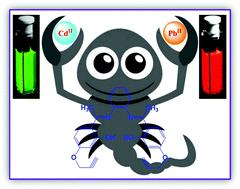Our official English website, www.x-mol.net, welcomes your
feedback! (Note: you will need to create a separate account there.)
Biocompatible alkyne arms containing Schiff base fluorescence indicator for dual detection of CdII and PbII at physiological pH and its application to live cell imaging.
Analyst ( IF 3.6 ) Pub Date : 2020-05-06 , DOI: 10.1039/d0an00862a S G Jebastin Andrews 1 , S Benita Jeba Silviya , Dharmaraj Jeyanthi , E Sathya Devi , J Winfred Jebaraj , Chithiraivel Balakrishnan
Analyst ( IF 3.6 ) Pub Date : 2020-05-06 , DOI: 10.1039/d0an00862a S G Jebastin Andrews 1 , S Benita Jeba Silviya , Dharmaraj Jeyanthi , E Sathya Devi , J Winfred Jebaraj , Chithiraivel Balakrishnan
Affiliation

|
An alkyne arms containing salen-type Schiff base ligand, 6,6′-((1E,1′E)-(1,2-phenylenebis(azanylylidene))bis(ethan-1-yl-1-ylidene))bis(3-(prop-2-yn-1-yloxy)phenol) (H2L), is reported here as a dual chemosensor for CdII and PbII ions. The ligand H2L was characterized by various spectral methods. The ligand H2L acts as a dual sensor for CdII and PbII in methanol/HEPES buffer (5 mM, pH 7.3; 1 : 9 v/v) at room temperature with well-separated excitation and emission wavelengths. The emission intensity at 553 nm of H2L is shifted and a new band appeared at 578 nm with the increase in the presence of CdII when it is excited at 420 nm. With excitation at 410 nm, the emission intensity of H2L at 485 nm shifted and a new band appeared at 505 nm with the increase in the presence of PbII. The quantum yield of H2L increases considerably in the presence of CdII and PbII. The compound H2L is non-fluorescent; however, in the presence of CdII and PbII, the compound H2L is highly fluorescent with well-separated excitation and emission wavelengths, indicating that the metal ion is coordinated through phenolic oxygen and imine nitrogen of the Schiff base blocking the PET (Photoinduced Electron Transfer) process and stimulating the CHEF (Chelation Enhanced Fluorescence) process, to increase the fluorescence intensity of H2L. The detection limit values of H2L are in a nano-molar range for both metal ions, confirming very high sensitivity of H2L. The L·MII binding mode and the recognition mechanism of the sensor were explored by Job's plot, 1H NMR, FT-IR, pH and DFT calculations. Besides, H2L was successfully utilized in cell imaging studies for both metal ions in MCF 7 cells.
中文翻译:

含有席夫碱荧光指示剂的生物相容性炔烃臂,可在生理pH下双重检测CdII和PbII及其在活细胞成像中的应用。
含萨伦型席夫碱配体,6,6-炔臂' - ((1个Ë,1' ë) - (1,2-亚苯基二(azanylylidene))双(乙烷-1-基-1-亚基))二(3-(prop-2-yn-1-yloxy)phenol)(H 2 L),据报道是Cd II和Pb II离子的双重化学传感器。配体H 2 L通过各种光谱方法表征。配体H 2 L在室温下以良好分离的激发和发射波长充当甲醇/ HEPES缓冲液(5 mM,pH 7.3; 1:9 v / v)中Cd II和Pb II的双重传感器。H在553 nm处的发射强度当在420 nm处激发时,随着Cd II的存在, 2 L发生位移并在578 nm处出现新的谱带。在410 nm激发下,随着Pb II的增加,H 2 L在485 nm处的发射强度发生了变化,并且在505 nm处出现了一个新的谱带。在Cd II和Pb II存在下,H 2 L的量子产率大大提高。化合物H 2 L是非荧光的;但是,在Cd II和Pb II存在下,化合物H 2 L具有高度荧光性,激发和发射波长分开,表明金属离子通过席夫碱的酚氧和亚胺氮配位,从而阻止了PET(光致电子转移)过程并刺激了CHEF(螯合增强荧光)过程,从而增加H 2 L的荧光强度。H 2 L的检测极限值在两种金属离子的纳摩尔范围内,证实了H 2 L的极高灵敏度。通过Job's图,1 H NMR,FT-IR,pH和DFT计算,探索了L·M II的结合方式和传感器的识别机理。除了,H 2 L已成功用于细胞成像研究中的MCF 7细胞中的两种金属离子。
更新日期:2020-06-29
中文翻译:

含有席夫碱荧光指示剂的生物相容性炔烃臂,可在生理pH下双重检测CdII和PbII及其在活细胞成像中的应用。
含萨伦型席夫碱配体,6,6-炔臂' - ((1个Ë,1' ë) - (1,2-亚苯基二(azanylylidene))双(乙烷-1-基-1-亚基))二(3-(prop-2-yn-1-yloxy)phenol)(H 2 L),据报道是Cd II和Pb II离子的双重化学传感器。配体H 2 L通过各种光谱方法表征。配体H 2 L在室温下以良好分离的激发和发射波长充当甲醇/ HEPES缓冲液(5 mM,pH 7.3; 1:9 v / v)中Cd II和Pb II的双重传感器。H在553 nm处的发射强度当在420 nm处激发时,随着Cd II的存在, 2 L发生位移并在578 nm处出现新的谱带。在410 nm激发下,随着Pb II的增加,H 2 L在485 nm处的发射强度发生了变化,并且在505 nm处出现了一个新的谱带。在Cd II和Pb II存在下,H 2 L的量子产率大大提高。化合物H 2 L是非荧光的;但是,在Cd II和Pb II存在下,化合物H 2 L具有高度荧光性,激发和发射波长分开,表明金属离子通过席夫碱的酚氧和亚胺氮配位,从而阻止了PET(光致电子转移)过程并刺激了CHEF(螯合增强荧光)过程,从而增加H 2 L的荧光强度。H 2 L的检测极限值在两种金属离子的纳摩尔范围内,证实了H 2 L的极高灵敏度。通过Job's图,1 H NMR,FT-IR,pH和DFT计算,探索了L·M II的结合方式和传感器的识别机理。除了,H 2 L已成功用于细胞成像研究中的MCF 7细胞中的两种金属离子。











































 京公网安备 11010802027423号
京公网安备 11010802027423号